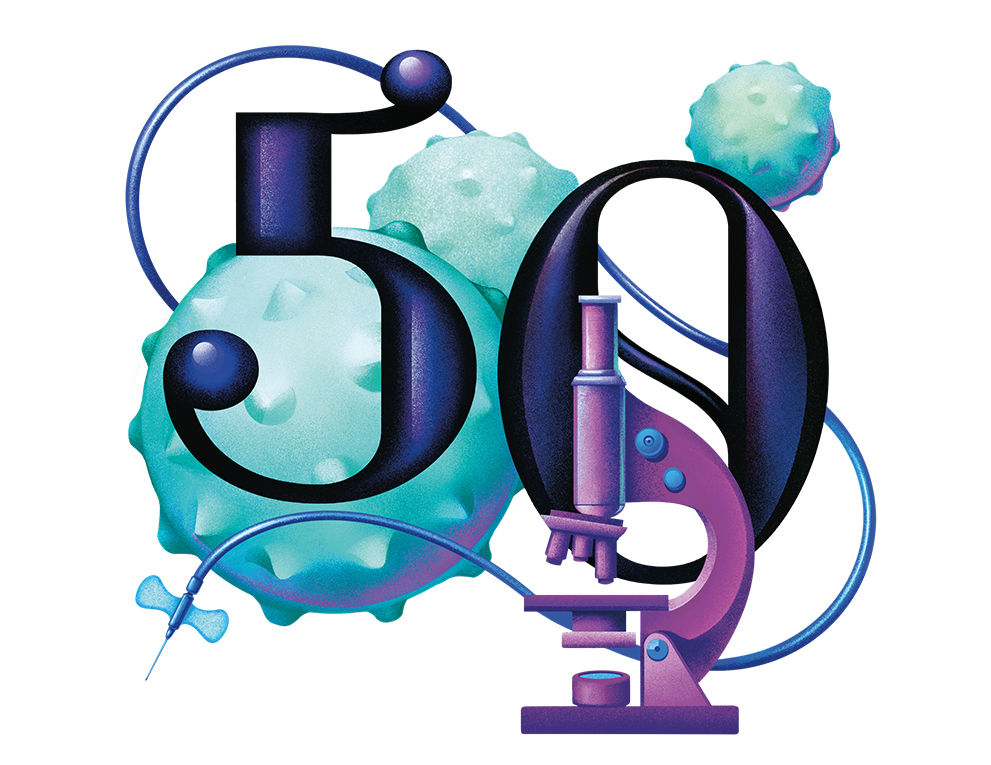From the Dean: Saving Lives for 50 Years
Celebrating the Johns Hopkins Kimmel Cancer Center’s golden anniversary.

Illustration by Chiara Vercesi
In 2023, we celebrated 50 years of unwavering dedication to cancer research and clinical care at the Sidney Kimmel Comprehensive Cancer Center. That’s 50 years of turning research into results — 50 years of saving lives.
I have a long history with this remarkable institution. As the inaugural director of the Department of Radiation Oncology and Molecular Radiation Sciences, I have seen the impact of Sidney Kimmel’s transformative gift firsthand. Thanks to Mr. Kimmel, the center that bears his name continues to advance cancer care.
Take, for example, some of the earliest research at the center, focused on bone marrow transplants. This work helped patients overcome the need for a fully matched donor, making bone marrow transplants possible for every patient in need. Kimmel Cancer Center researchers also unearthed the genetic underpinnings of cancer. Our physicians and scientists have used this insight to develop pioneering genetic tests, screening diagnostics and targeted therapies.
And before we had advanced radiosurgery equipment, Johns Hopkins’ own Dr. Moody Wharam co-pioneered a groundbreaking method to deliver radiation with millimeter accuracy. This innovation saved the vision of a toddler who would have otherwise lost his sight.
I know because that toddler was my very first patient at Johns Hopkins.
The Kimmel Cancer Center’s research and treatment methods have only improved since then. Our clinical care is more personalized than ever before, as our genetic and genomic expertise enables more effective and individualized therapies. This increases the likelihood of success for patients and spares others from exposure to potentially futile, or even painful, treatment attempts.
Additionally, technological advancements allow us to better care for each patient as an individual. Updated evaluative technology — such as scanning, pathology and blood tests — better identifies patients’ conditions, while refined delivery methodologies reduce side effects. With these innovations, we’ve been able to expand our outpatient treatment options so more patients can receive care without admission to the hospital — exactly when they need that comfort most.
Yet perhaps the most remarkable change lies in our patients’ mindsets. Fifty years ago, patients often viewed a cancer diagnosis as a death sentence. Today, patients can approach their diagnoses with understanding and hope. The Kimmel Cancer Center deserves great credit for creating this hope with its profound vision and pathbreaking achievements.
“Fifty years ago, patients often viewed a cancer diagnosis as a death sentence. Today, patients can approach their diagnoses with understanding and hope.”
As a still-practicing radiation oncologist, I’m filled with hope, too. There’s more work to be done, with so many counting on us. But over the past few decades, cancer death rates have plummeted. The future promises even greater strides. Together, we are moving closer to a reality where many cancers can be cured and, if not cured, can be considered a chronic condition — manageable in everyday life.
We’re already seeing spectacular improvements in cancer diagnostics, enhancing early detection. And I’m thrilled to see the center continue to embrace immunology as a partnering field, including new immunotherapies that have shown long-lasting responses across many cancer types. At the same time, the dedicated pediatric team at our new Johns Hopkins Proton Therapy Center — one of the few in the world — is transforming care for our youngest oncology patients.
These children make me think of the toddler whose sight we saved so many years ago. Today, he is a married man, pursuing a law degree.
Every patient deserves that bright future. The Johns Hopkins Kimmel Cancer Center will continue to realize that vision over the next 50 years. I can’t wait to see what we achieve for medicine, for science and, most of all, for generations of patients to come.
